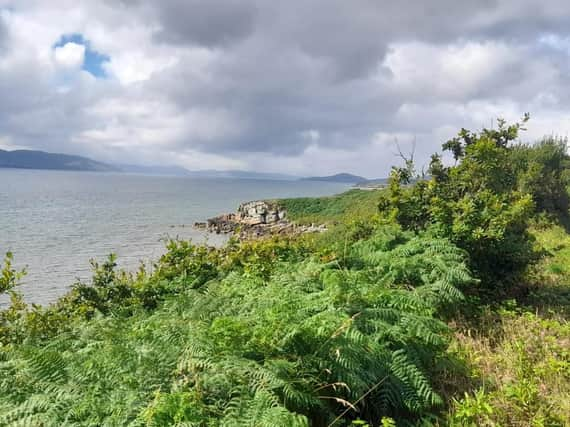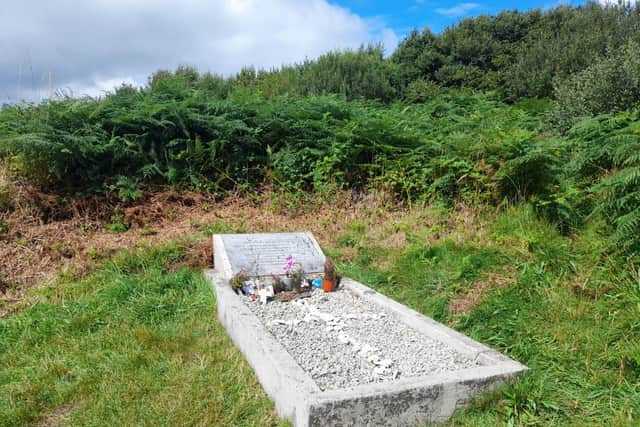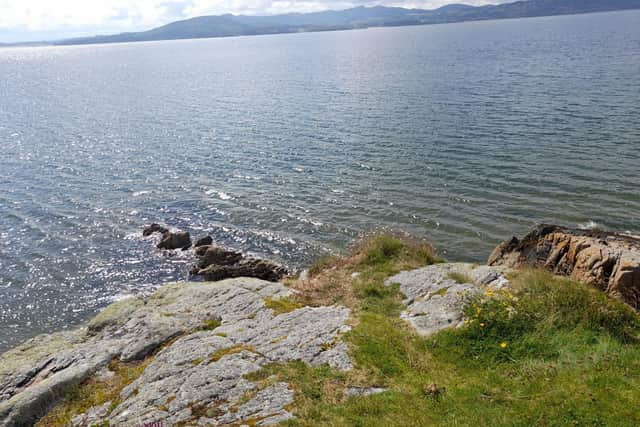The murder of Friar Séamus ‘James’ O’Hegarty by the English in 1711


His head was cut off by an English officer named Vaughan at an unspecified date in 1711. Local lore has it that Fr. O’Hegarty’s severed head bounced nine times on the rocky promontory on which it fell. Forever since the distinctive outcrop has borne the name - ‘Fr. Hegarty’s Rock.’
It is said a rough cross formed by the lineaments in the rock face marks the very spot where his head fell after it was parted from his body.
Advertisement
Hide AdAdvertisement
Hide AdWhatever the truth of this, the pattern of a cross is clearly visible. Today a nearby plaque and a shrine remind visitors to this popular beauty spot of its bloody history: “This plaque marks the spot where in penal times Friar Séamus Hegarty O.P. was beheaded in 1711. After surrendering to British Forces. Born in 1649. Ordained by Oliver Plunkett at Dundalk in 1672. Friar Hegarty was P.P. in Fahan. From 1704 until his death.”


Fr. O’Hegarty was a harried priest operating as he did during the time of the Penal Laws, which persecuted Catholics and Presbyterians in Ireland in the 1600s and 1700s.
These included the Education Act (1695) that prohibited the Irish from sending their children to Europe to be educated; the Banishment Act (1697) that sought to banish Catholic clergy - an important leadership cadre for the native population at the time - from Ireland entirely; and the Registration Act (1704) which required any ‘Popish’ priests remaining in the country to register with a local magistrate and to pay a bond to guarantee their good behaviour.
John Keys O’Doherty, who was Bishop of Derry from 1889 to 1907, tells us in an account of Fr. O’Hegarty’s murder in the Irish Ecclesiastical Record, 4th Series, Vol. XV, No. 438, June, 1904. how the Inishowen cleric had complied with the latter legislation.


Advertisement
Hide AdAdvertisement
Hide Ad“The priests regarded this law of registration as a kind of toleration if not of protection, and believed that by complying with it they would secure peace to follow their sacred calling, and to minister to the spiritual necessities of their flocks. Little they dreamed it was a deep-laid plan to effect their ruin by giving them the choice of death of apostacy. Yet this was the dilemma in which an Act passed in 1709 placed them,” wrote O’Doherty, almost 200 years after O’Hegarty was killed.
O’Doherty is referring to the 1709 Popery Act which required registered priests to reject the doctrine of transubstantiation (according to Catholic theology the conversion of the Eucharist into the body and blood of Christ), Mass and the adoration of The Virgin Mary and the Saints.
A list of those who had registered includes the name of Fr. James O’Hegarty. First published by an ‘Andrew Crook, Printer to the Queen’s Most Excellent Majesty on the Blind-Key, 1705, Dublin’ it records: “Registered at a General Sessions of the Peace held for the said County of Donegall, at Raphoe, July 11, 1704, James Hegarty, aged 55, residing at Gortergan, Parish Priest of Fawn [sic - Fahan] etc., ordained at Dundalk, in May 1672, by Oliver Plunkett, Titr. Primate of Ireland.”
While Fr. O’Hegarty was prepared to register in 1704 he was not prepared to abjure the Catholic beliefs and doctrines specified in the 1709 act. According to the present day Parish of Buncrana registered clerics may have been required to swear an Oath of Abjuration by March 25, 1710, but of the 1,089 priests known to have registered in 1704, ‘only 33 are known to have taken the Oath of Abjuration’.
Advertisement
Hide AdAdvertisement
Hide AdFr. O’Hegarty’s refusal made him a fugitive from the ‘spies, informers, and priest-hunters’ who stood to gain considerable sums for the capture of clerics with suspected Jacobite sympathies. It was thus he sought refuge in a lonely cave on the shores of the Swilly from where he continued to administer to his flock.
Michael Harkin, of Carndonagh, in his ‘Inishowen, its History, Traditions, and Antiquities,’ published in 1867, relates: “In the village of Ballynarry, about two miles north-west of Buncrana, on the banks of the Swilly is a sea-cave which served as hiding-place for a humble and zealous priest of the name of O’Hegarty.
"From this wild seclusion he was accustomed to steal, under the shadow of night, to carry the ministrations of his religion to the hearths of the faithful fishermen around the coast, and the hardy mountaineer farther inland.
"His retreat was unknown to all but his sister, who lived with her husband and family in the above-named village. None of her family ever questioned her when she departed from her cottage in the grey dawn each morning to carry him the provisions for the day.
Advertisement
Hide AdAdvertisement
Hide Ad"At last, her husband suspecting her mission was led by curiosity to watch her unseen, and so became acquainted with the hiding-place of her fugitive brother. This once known, he had not the fidelity to keep secret, for tempted by the reward held out for such a discovery, he led a guard of soldiers from the garrison to apprehend the priest, his own brother-in-law in that lonely dwelling.”
O’Doherty claims tradition held Fr. O’Hegarty’s sister was named Mary and she was wed to a Thomas Doherty.
An earlier prelate, Dr. Edward Maginn, coadjutor Bishop of Derry, in 1846, states that after his betrayal: “He was dragged from a mountain cavern - his hiding-place by day (by night only could he appear in those times, commune with his flock, instruct the living, console the dying, and bury the dead) - and was butchered on a rock on the banks of the Swilly, which shall be ever memorable from this bloody tragedy. The perpetrator of this murder was a Captain Vaughan, the son of an English colonel who served in the army of Oliver Cromwell (as Carlyle would say) ‘of blessed memory.’
“The good captain believed he was doing the work of God, when imbruing his hands in the blood of Popish priests, as many now believe they are doing the same holy work in calumniating them.”
Advertisement
Hide AdAdvertisement
Hide AdHarkin gives a vivid account of what is believed to have occurred. Mary Doherty (née O’Hegarty) went down to her brother’s hiding-place with victuals as was her habit. After receiving a blessing from the friar she was horror-stricken to discover a raiding party of soldiers descending towards the shoreline.
“She called frantically to her brother that the guard was upon him. He rushed from the cave, above him were the soldiers, beneath the whole breadth of the deep flowing Swilly, but deeming it friendlier of the two, and putting his trust in God, he plunged into its depths with the bold, almost reckless resolve of swimming to the opposite shore.
"The guard, seeing they were in danger of losing the object of their pursuit, or fearing that if they fired and killed him in the water they should have no evidence of the fact, called on him to return and they would spare his life.”
This act of perfidy persuaded the cleric to the shore, Harkin reports.
Advertisement
Hide AdAdvertisement
Hide Ad“But no sooner had he gained the top of the precipice than they seized him, cut off his head, and buried his body on the spot where they had committed the deed.”
Harkin writes that the peasantry were afraid to mark the grave for fear of vengeance.
“Yet was the memory of the place so engraven on their hearts, and carefully transmitted from father to son, that the villagers’ children could at any time point out to the curious stranger that sad memento of the horrors of by-gone days, under the name of Hegarty’s rock.”
Many readers will be familiar with versions of this story and of the legend that his head bounced a number of times on the rock after he was beheaded. Back in the 1930s the Buncrana school teacher Eoghan Ua Gallchobhair recorded it as part of the Irish Folklore Commission’s Schools’ Collection.
Advertisement
Hide AdAdvertisement
Hide Ad“The head is supposed to have hopped nine times on the ground and to have made nine holes. These holes are still to be seen there. These holes are in three rows of three and no grass grows in them. Vaughan received £5 for the priest’s head. His body was buried close to the spot where he fell and the grave is still to be seen there.
"Many people come to see it. On it are many medals, beads, etc. The rock at the shore near where he was killed is still called Fr. Hegarty’s Rock. When a person is going along the shore some distance away, the clefts in the rock seem to him to form a black cross.”
Bishop O’Doherty writes that Mary Doherty left her husband to live with a family named ‘M’Donald’ in Buncrana. Thomas Doherty was reportedly killed by an outlaw named ‘Stumpy’ who he had been attempting to bring in from the Glenshane for a ‘gentleman’ from Maghera.
“What a life of toil, of misery, and of danger did Father Hegarty lead! Wandering the deep glens and rugged hills of the extensive district of which he had charge; lighted by the moonbeams, or groping his way beneath a starless sky, he went from cabin to cabin in sleet and storm to administer the Last Sacraments to the poor but faithful people, to baptize the little ones, to console the suffering and afflicted, or to offer up on a bare rock or bleak mountainside the Holy Sacrifice for the living and the dead.”
Advertisement
Hide AdAdvertisement
Hide AdThis was likely an accurate description of the realities of the early 1700s when Gaelic civilisation was enduring a near apocalypse.
He concludes: “No long procession or funeral pomp accompanied him to the grave; no solemn dirge nor swinging censer consecrated his last dwelling-place; but the waters of the Swilly for nigh two centuries chanted their Miserere around his lonely habitation; and the breezes of the Lake of Shadows, round which for years he ministered, have ceaselessly sung their Benedictus over the ashes of him who the vox populi has long since canonized as the Martyr of Inishowen.”
